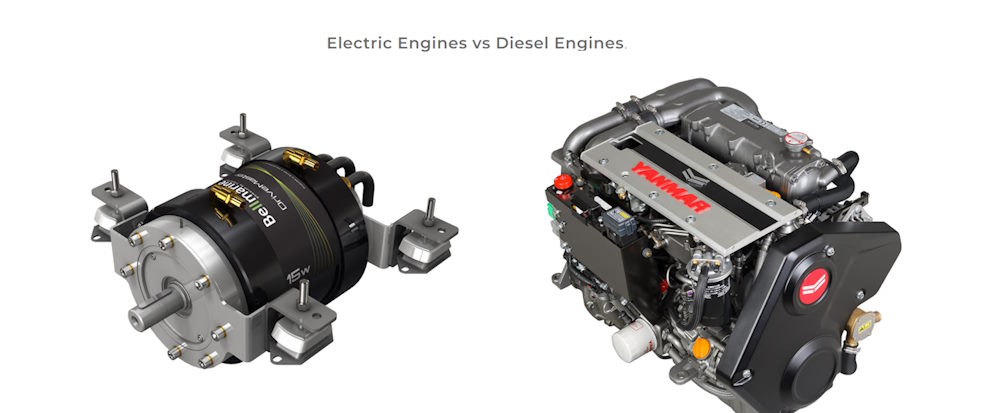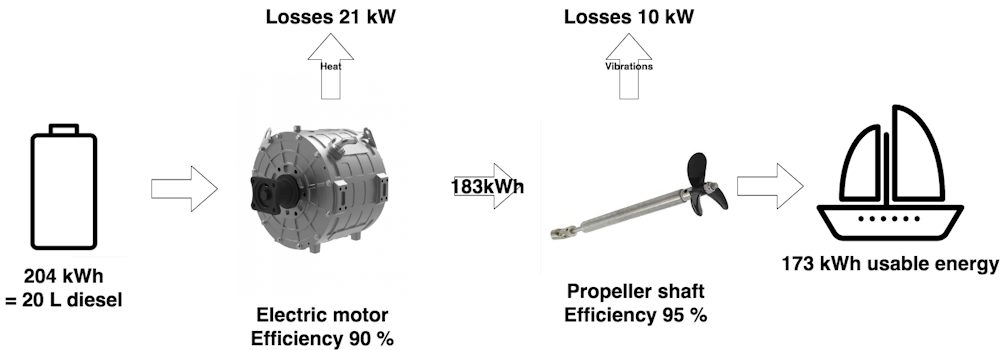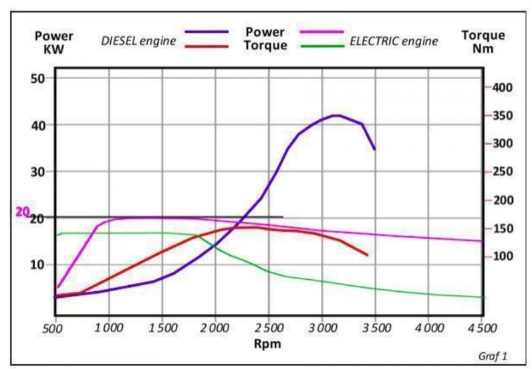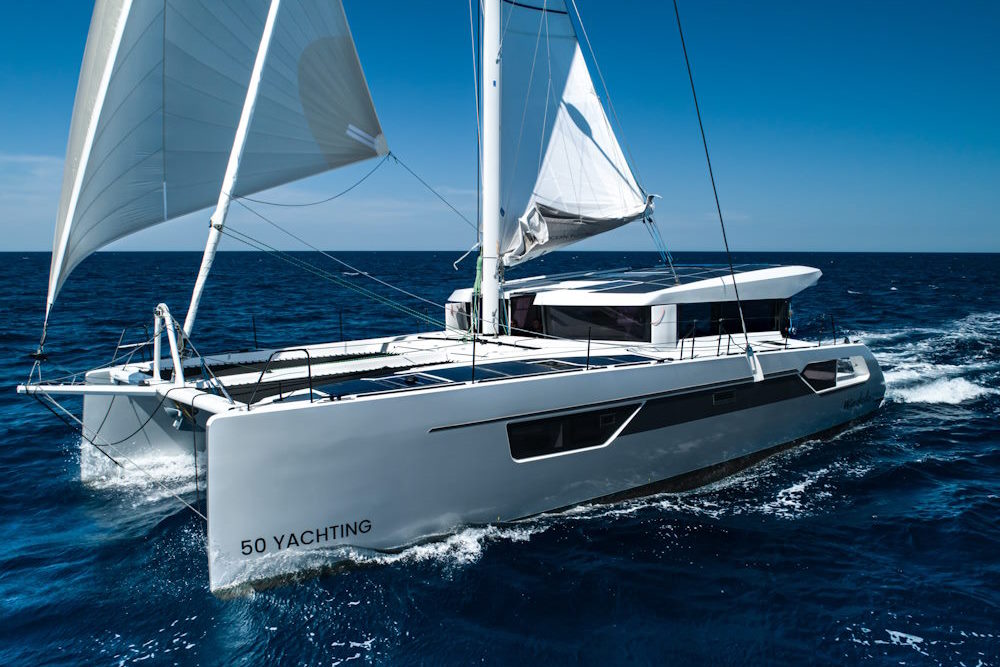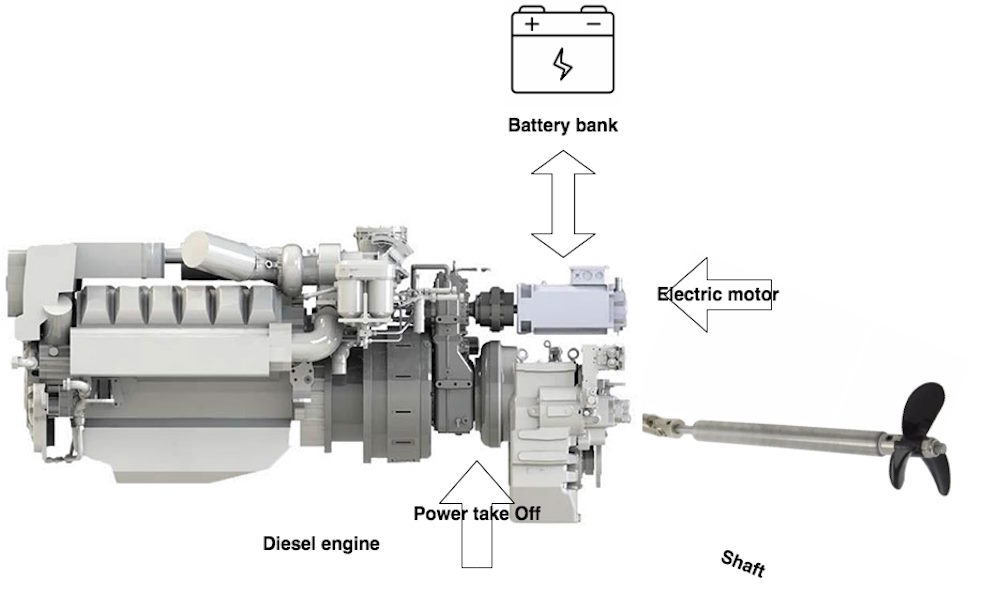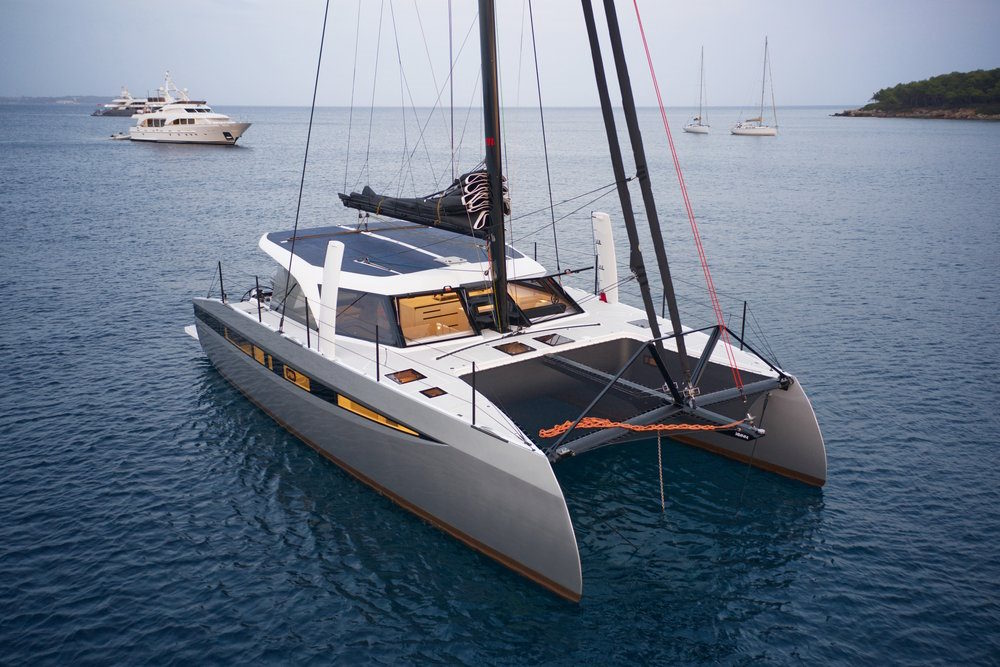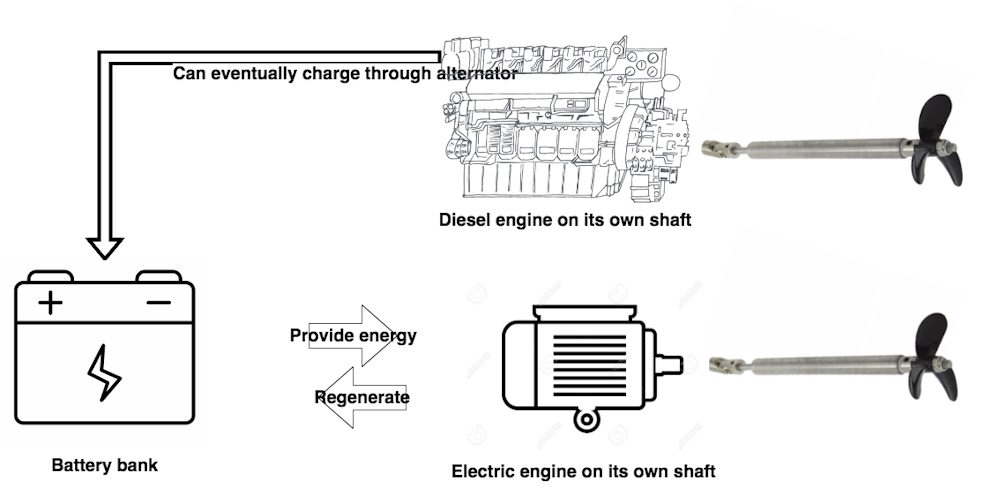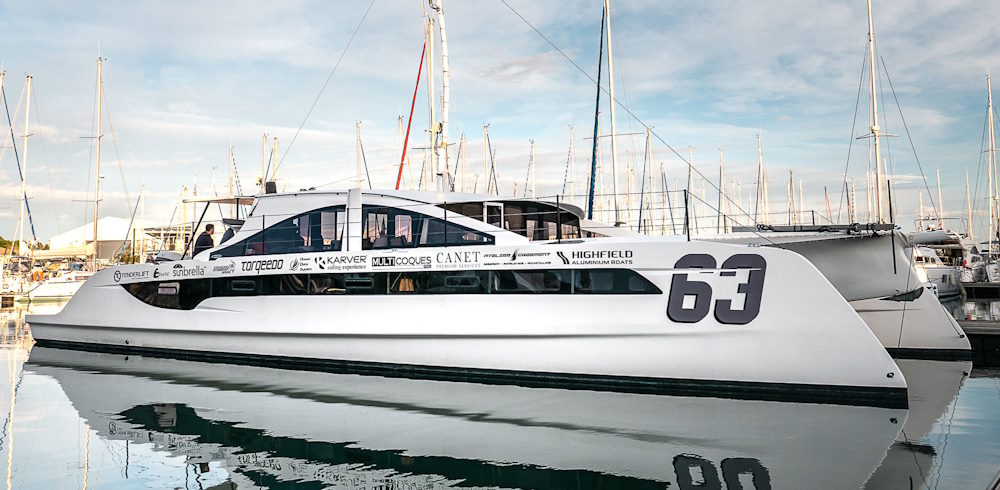By François Meyer | January 2024
Last season’s boat shows allowed us to visit and test several electric and hybrid-electric catamarans. It is now a reality: catamarans no longer necessarily have diesel auxiliary propulsion but can be equipped with electric motors.
But how do they work and how do we compare their performance to more traditional power units? Electric, hybrid, power, voltage, charging, autonomy: there are many questions that arise from these configurations.
The aim of this article is to explain the various technologies and see things more clearly. For example, we will take a look at Electric Engines vs Diesel Engines and compare serial and parallel hybrid power systems.
Definitions
Range and Power Density
Range and autonomy play a key role within cruising catamaran capabilities. Diesel delivers a huge range because of the high power density of this fuel.
For diesel, one 20 litre jerrycan of diesel (25 kg including the can) contains 204 kWh energy, which is very substantial compared to a battery bank. If you wanted to store 204 kWh energy in a battery bank, it would weigh more than 1200 kg.
The high power density of fossil fuels is one of the main reasons for the dependence of the industrialised world on this fuel. Conserving power within batteries costs a lot of weight and money and requires powerful inboard charging.
Efficiency
Diesel Engines
Because of the high power density of fossil fuels used in combustion engines, the efficiency of diesel ones, was not such an important consideration, especially in boating.
The average overall efficiency of a diesel engine rarely goes beyond 40%. It means you “lose” around 60 % of fuel within the process. Lots of internal mobile parts generate friction and heat which is the main loss.
Furthermore, most catamarans use saildrives. This transmission choice, saves space inside the hulls, but comes with around 10% more losses (gears) compared to a shaft drive.
So at the very end of the day, from an energy point of view, a catamaran fitted with diesel saildrives is not very efficient.
Efficiency of Diesel Engines
Electric Engines
On the other hand, there are not as many moving parts in an electric engine that uses a low friction magnetic field to operate. Their overall efficiency is much higher, higher than 90% in the case of the Permanent Magnet electric motors used in marine vessels.
Better efficiency means also avoiding waste! For that reason, most newbuild catamarans are choosing shaft drives, not
saildrives, to achieve better overall efficiency. Electric saildrives, like Oceanvolt Servoprop, are mainly designed for saildrive designed boats whose bilges are simply too small to receive a shaft.
Efficiency of Electric Engines
Downsizing : Diesel and Electric Power Engine Comparison
You may have already noticed this, but electric catamarans are commonly fitted with engines whose power rates well below diesel ones. Firstly there is the conversion factor between horsepower and kilowatt. This is just maths, as 1 kilowatt (kW) is equivalent to 1,36 HP.
The big difference is in torque availability. A diesel engine has its nominal power and torque (the ones that are advertised) at high RPM, at a much higher speed than an engine should be used.
On the graph below, we see power and torque of both diesel and electric engines.
For a traditional setup, the power is represented by the dark purple curve at high RPM of a diesel engine (max at 3200 RPM).
If we look at the light purple curve (electric engine), this shows the power of an electric motor is almost constant, after starting.
Let’s now have a look at the torque curves. Torque is the force which turns the propeller and propels the boat.
At 1800 RPM, both motors benefit from 100% of their torque. To achieve 150 Nm of torque, the electric motor needs only 20 kW while the diesel requires 42 kW!
The combination of high torque-low RPM and better overall efficiency mean that you can downsize electric engines when compared to diesel ones. The downsizing sits between a factor of two and three.
System Tension
One of the basic rules of electricity involves the relationship between power, voltage and current.
Power (W) = Voltage (V) x Current (A). The higher the voltage is, the lower the current. Lower amps means, on a boat, smaller diameter cables. But higher voltage also means lethal danger.
There is a physiological limit for a human being (above 120V DC): the heart can be stopped by electrical shock. In wet conditions, this limit goes to 60V DC. That is why most hybrid catamarans are wired at 48V, well below 60.
Some boatbuilders, like Fountaine-Pajot with the Smart Electric Series (Aura 51, Elba 45…) use a 400V DC setup. It is a boatyard choice, but only very educated and skilled tradesman will work on such systems when any marine electrician will be happy to work the more common 48V system.
Electric, or hybrid?
Electric catamaran
An electric catamaran is a vessel whose principal propulsion is provided by the wind and whose auxiliary propulsion is provided by an electric motor. On board a 100% electric catamaran there is no combustion engine and no other energy than electricity.
There are not many 100% electric catamarans around as their range, dependent on battery capacity and onboard chargers, is too low for cruising.
The story of Jimmy Cornell’s Outremer 4.Zero is interesting as the renowned sailor decided to go, against the will of the yard, with a full electric (ie. not carrying a diesel genset). In the end, power consumption and power production were not in balance and the fossil free circumnavigation project failed. Relying only on a small sized solar panel array
(1,3 kWh) and relatively inefficient regeneration, the boat’s energy consumption was simply too high.
On that boat, fitted with 2 x 10 kW Oceanvolt Servoprop saildrives and 17,5 kWh of batteries, the range, motoring, at mid RPM is less than two hours. Regeneration was delivering around 300 Wh, (0.3 kWh), too few to refill the batteries while using all of the electric appliances.
Hybrid Catamarans
A hybrid catamaran is a vessel whose principal propulsion is provided by the wind and whose auxiliary propulsion is provided by different means including an electric engine. Its system uses two or more power sources on board.
Hybrid catamarans can be equipped with an auxiliary main diesel propulsion, assisted by a secondary electric one (parallel hybrid or bi-motorization), or with auxiliary electric engines relying on batteries that can be recharged under way by a generator (diesel, hydrogen, methanol), ie a serial hybrid. This greatly increases the range.
Because of the requirement for a good range, most of the so-called electric catamarans like the Windelo 50, HH44, Fountaine-Pajot Smart Electric Series, O-Yachts Class 66 Eco are hybrid catamarans.
Serial Hybrid Catamarans
A serial hybrid catamaran is propelled by two electric motors. Those motors get their power from batteries which are being charged while sailing using various means.
Solar (photovoltaic) panels account for an important share of renewable energy in the energy mix. Hydrogeneration does not depend on light and can deliver power at night, when sailing a passage.
Serial hybrid catamarans always have a back-up power generator to fill the batteries when needed. The generator can be diesel, or in the future hydrogen, ammonia or methanol (fuel cells).
The Windelo 50 is probably the most efficient serial hybrid sailing catamaran on the market.
Light and fast, she sails well and her two 20 kW electric engines with shaft drive deliver the best efficiency possible. Wired in 48 VDC, with 53,8 kWh of battery capacity (propulsion, 6 kWh house bank), the boat boasts a 5,5 kWc photovoltaic array.
Under sail, on a passage, the boat produces enough power to cover its consumption and slowly charges its batteries. Solar gives her between 20 to 30 kWh per day (depending on latitude) and hydro regeneration, around 24 kWh per day when sailing 10 knots.
But, if needed, the generator can be started, delivering 17 kWh to the battery bank to replenish it within hours. Or, if they are empty, to provide 6 knots motoring speed, the genset is used.
Combining those three methods of charging, the yard claims a 1100 NM range, which is twice the range of a Lagoon 42 with its two 57 HP diesels.
Nevertheless, the Lagoon 42 still has the advantage of power as it can increase its RPM when motoring against waves and tide to cruise at 7 knots while burning more fuel. The Windelo cannot do that, and, in such conditions, its motoring speed will lower.
The Lagoon retains a second advantage as if one diesel fails, the boat still has the other to
motorsail.
If Windelo loses its genset at night with depleted batteries, she will have to rely on her sails. Some owners choose a 2 genset configuration for redundancy, but that does add weight and cost.
Parallel Hybrid Catamarans
This set-up uses an electric motor mounted on the diesel engine, both capable of moving the propeller. Where the serial hybrid has two functions (moving and regen), the parallel has four.
The diesel engine can propel the boat. While doing that, it can also move the electric engines which will produce some power, acting as a generator.
The electric engine can move the propeller, diesel off. And, in emergency cases, both electric and diesel engines can move the prop, in a kind of boost mode.
The parallel hybrid yachts do not need any generators as their engines behave as powerful ones. This setup fits particularly well for cruising catamarans as you can enjoy the joy of silent sailing or electric motorsailing but you can always rely on your trusty diesels if needed.
The two systems do not rely on each other and offer an interesting case of redundancy.
A catamaran like the HH44, charges 5,4 kWc from solar and has two 30 HP diesel + 2 10 kW electric motors using a 43,2 kWh battery bank. While diesel motoring, the boat delivers 10 kW to charge the batteries. A sunny day can also fully charge the bank.
Those 43,2 kWh can propel the yacht at 6 knots for a couple of hours. Total range (diesel) is around 628 NM, according to the yard, a range which comes with a good dose of redundancy.
Bi-motorised hybrid catamaran
This third hybrid mixes 2 independent propulsion systems, a diesel one and an electric one.
O-Yachts offers, in its Class 66 Eco, a bi-motorised setup for example. One hull has a conventional diesel with shaft and the other an electric engine with a shaft-drive.
As the two systems are totally separated, the redundancy is there. The boat can be sailed with one engine, diesel or electric, and a small 5° rudder correction will drive the boat straight. Diesel alternator, regeneration and solar replenish the batteries.
This setup, although interesting, suffers from a disadvantage. As the two engines are different, they behave differently and this can cause issues manoeuvring in the marina. The skipper will need plenty of experience in different conditions before fully mastering the boat.

